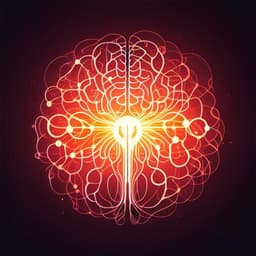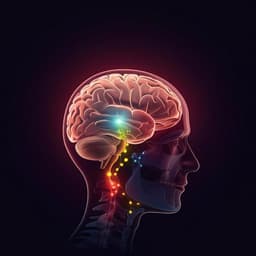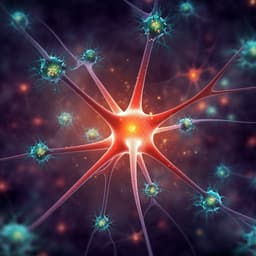
Medicine and Health
Hippocampal astrocytes modulate anxiety-like behavior
W. Cho, K. Noh, et al.
This fascinating study by Woo-Hyun Cho and colleagues reveals how hippocampal astrocytes play a crucial role in regulating anxiety-like behaviors in mice. By increasing intracellular calcium through optogenetic activation, researchers found that these astrocytes can induce anxiolytic effects by enhancing synaptic transmission, hinting at innovative therapeutic possibilities for anxiety disorders.
Playback language: English
Introduction
Astrocytes, glial cells forming part of the tripartite synapse, actively participate in regulating synaptic transmission and plasticity. Their perisynaptic processes monitor synaptic signals via neurotransmitter receptors, and they release gliotransmitters to influence synaptic transmission. This bidirectional communication with neurons has been shown to impact various aspects of neuronal function and even animal behavior. Growing evidence suggests a significant role for astrocytes in psychiatric disorders. Postmortem studies of human brains have revealed alterations in astrocytic morphology and volume in mood disorders such as major depressive disorder (MDD). Furthermore, astrocytes have been implicated in anxiety-like behavior in animal models of post-traumatic stress disorder (PTSD), and their activation in specific brain regions, like the central amygdala, has been shown to reduce anxiety. The hippocampus, known for its crucial role in memory and emotional regulation, is also implicated in anxiety. Specifically, activation of dentate gyrus (DG) granule cells is associated with anxiolytic effects, and CA1 pyramidal cells in the ventral hippocampus have been identified as "anxiety-response neurons." While previous research has focused on hippocampal neurons and neural circuits in anxiety, the role of hippocampal astrocytes in anxiety manifestation remains largely unexplored. Hippocampal astrocytes' roles in memory formation have been extensively studied, with findings demonstrating that their activity influences hippocampus-dependent functions and behaviors. Given the hippocampus's influence on affective behavior, the researchers hypothesized that hippocampal astrocytes might also influence anxiety-related behavioral responses. This study aimed to investigate this hypothesis by examining the relationship between hippocampal astrocyte calcium activity, anxiety state, and the underlying mechanisms.
Literature Review
Existing literature highlights the multifaceted roles of astrocytes in brain function and behavior. Studies have demonstrated that astrocytes modulate synaptic transmission and plasticity through the release of gliotransmitters. These gliotransmitters, including ATP, glutamate, and D-serine, interact with neuronal receptors to influence neuronal activity. The involvement of astrocytes in psychiatric disorders, particularly mood disorders and anxiety, is increasingly recognized. Postmortem brain tissue analysis has shown morphological and volumetric changes in astrocytes from individuals with MDD. Animal models of PTSD have also revealed a correlation between astrocytic dysfunction and anxiety-like behavior. Studies focusing on specific brain regions have shown that astrocyte activation in the central amygdala can have anxiolytic effects. The hippocampus's critical role in emotional regulation and anxiety is well-established, with research pointing to the involvement of specific neuronal populations in anxiety-related behaviors. However, the specific contribution of hippocampal astrocytes to anxiety remained unaddressed, prompting this study's investigation.
Methodology
This study utilized a multi-faceted approach combining in vivo two-photon calcium imaging, optogenetic manipulation, electrophysiology, and behavioral assays in mice. To investigate the relationship between hippocampal astrocyte activity and anxiety, the researchers generated astrocyte-specific GCaMP6s transgenic mice (hGFAP-GCaMP6s) by crossing hGFAP-creERT2 mice with floxed-stop-GCaMP6s mice. These mice expressed GCaMP6s, a calcium indicator, specifically in astrocytes, enabling in vivo monitoring of astrocytic calcium activity using two-photon microscopy. Awake, head-fixed mice were exposed to a virtual reality (VR) environment mimicking an elevated plus maze (EPM), an established anxiety test. Intracellular calcium activity (ΔF/F) in hippocampal astrocytes was measured while mice navigated the VR environment, allowing researchers to correlate astrocyte activity with the mice's behavior in anxiogenic (open arm) and less anxiogenic (closed arm) environments. To examine the causal relationship between astrocyte activation and anxiety-like behavior, astrocyte-specific channelrhodopsin 2 (ChR2) transgenic mice (hGFAP-ChR2) were generated using a similar crossing strategy. Optogenetic stimulation with blue light was used to activate hippocampal astrocytes and subsequently assess the effects on anxiety-like behavior in the EPM and open field test (OFT). Electrophysiological recordings from dentate gyrus (DG) granule cells in acute hippocampal slices were performed to determine the effects of optogenetic astrocyte activation on neuronal activity. Spontaneous excitatory postsynaptic currents (sEPSCs) were measured to evaluate changes in synaptic transmission. The release of potential gliotransmitters (ATP, glutamate, D-serine) from activated astrocytes was measured in both primary astrocyte cultures and hippocampal slices using bioluminescence and fluorometric assays. Pharmacological manipulation using PPADS, a purinergic receptor antagonist, was employed to determine the role of ATP signaling in the observed behavioral and synaptic effects. Various behavioral tests including the EPM, OFT, T-maze, and real-time place preference (RTPP) were utilized to assess anxiety-like behavior, locomotor activity, and hippocampus-dependent memory function. Statistical analysis was performed using appropriate methods to compare groups and determine statistical significance.
Key Findings
In vivo two-photon calcium imaging revealed that hippocampal astrocytes exhibited increased intracellular calcium levels when mice explored the anxiogenic open center of the VR-EPM, indicating a correlation between astrocyte activity and anxiety state. Optogenetic activation of hippocampal astrocytes using ChR2 resulted in anxiolytic effects in both the EPM and OFT. Mice showed increased exploration time in the open arms of the EPM and increased total distance traveled in the OFT. These anxiolytic effects were not associated with impairments in hippocampus-dependent spatial memory tasks. Electrophysiological recordings demonstrated that optogenetic astrocyte activation increased the frequency of sEPSCs in DG granule cells without affecting their amplitude. This increase in sEPSC frequency was attributed to ATP release from activated astrocytes, as ATP application directly increased sEPSC frequency in DG granule cells, and this effect was blocked by PPADS, a purinergic receptor antagonist. Pharmacological blockade of purinergic receptors using PPADS largely abolished the anxiolytic effects of optogenetic astrocyte activation in the EPM, indicating a critical role for ATP signaling in mediating the anxiolytic behavior. The study also showed that ATP, but not glutamate or D-serine, was significantly released from activated astrocytes in hippocampal slices. This suggests a specific role for ATP as a mediator of astrocytic influence on anxiety-like behavior.
Discussion
This study provides compelling evidence for a direct role of hippocampal astrocytes in modulating anxiety-like behavior in mice. The findings demonstrate a clear link between astrocyte calcium activity, synaptic transmission, and anxiety-related behaviors. The observed anxiolytic effects of optogenetic astrocyte activation are likely mediated by ATP release, which enhances excitatory synaptic transmission in the DG. This mechanism highlights a novel therapeutic target for anxiety disorders. The long-lasting anxiolytic effects observed even after cessation of light stimulation suggest that astrocyte-mediated synaptic plasticity could contribute to the sustained behavioral changes. While this study focuses on ATP, other gliotransmitters may also play a role under different conditions or in different behavioral contexts. Future investigations should explore the specific mechanisms of astrocyte activation in response to anxiogenic stimuli, the role of other gliotransmitters, and the involvement of hippocampal astrocytes in other hippocampus-dependent functions beyond anxiety.
Conclusion
This study unveils a crucial role for hippocampal astrocytes in the modulation of anxiety-like behavior. Optogenetic activation of these astrocytes leads to ATP release, enhancing excitatory synaptic transmission and producing anxiolytic effects. This finding offers a promising avenue for the development of novel therapeutic strategies targeting astrocytes for the treatment of anxiety disorders. Further research is needed to explore the specific molecular mechanisms involved and to investigate the translational potential of these findings in clinical settings.
Limitations
While the study provides strong evidence for the involvement of hippocampal astrocytes and ATP in anxiety modulation, several limitations should be considered. The use of transgenic mice may not fully capture the complexity of astrocyte function in natural conditions. The study primarily focused on male mice; future studies should investigate potential sex differences. The virtual reality environment, while a useful tool, may not perfectly replicate the experience of a real elevated plus maze. Further investigation is warranted to determine the exact mechanisms underlying the long-lasting anxiolytic effects observed after light stimulation.
Related Publications
Explore these studies to deepen your understanding of the subject.







